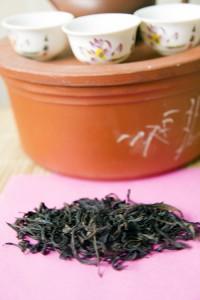As mentioned previously, there is no single all-encompassing “Chinese tea culture”. Tea culture in Chengdu is markedly different from that in Chaozhou which in turn differs from Hangzhou and Beijing, just to name a few.
In Singapore our heritage Chinese tea is intricately linked to our ancestral home.
The 2 biggest dialect groups, namely the Hokkien (Fujian) 福建 and the Teochew (Chaozhou) 潮州 have come to define to a large extent what Chinese tea meant in local context, at least traditionally.
As a result, even though oolong tea only constitutes 14% of all teas produced in China, it is the traditionally dominant Chinese tea in Singapore.
Fujian and Chaozhou are the 2 bedrocks of oolong tea culture and jointly account for virtually all the oolong tea produced in China. Hence it is unsurprising that until the last 10 years or so, Singapore Chinese tea is virtually synonymous with oolong and to a lesser extent Puer which we will look at later.
Hokkien (Fujian) 福建
Though the term ‘Fujian’ is used, in this context it generally refers to Minnan 闽南 as opposed to the entire province of Fujian. In fact though locally we refer to the dialect as ‘Fujian’ it is actual Minnan. For instance, Hokchiu (Fuzhou)福州 people are considered a separate dialect group.

Even today, some of the most established tea merchants in Singapore are Minnan in origin- Pek Sin Choon Pte Ltd, Wang San Yang Tea Merchants, Nan Yuan (Tea Pal) just to name a few.
Any mention of Anxi, Minnan and tea is of course incomplete without mentioning Tieguanyin (铁观音). From the restaurants to Bak Kut Teh joints and high end tea house, you can get Tieguanyin- albeit of vastly different grades.
In fact, even many temples of that time ‘offered’ Tieguanyin to their deities.
Minnan Oolong did not begin and end with Tieguanyin though. Huang Jin Gui 黄金桂 and other Sezhong (色种) gained popularity in Singapore with some merchants specializing in their own house blends such as Unknown Fragrance (不知香) for example.
Minbei 闽北
Though the Minbei population in Singapore was not well represented, their tea was. Wuyi teas continued to make the passage over to South East Asia, almost as seamlessly as it was from Wuyishan to Zhangzhou (Minnan).
Wuyi Yancha- particularly Shuixian- were popular among the local tea lovers. Minbei Shuixian particularly those from JianOu was also a popular offering at restaurants.
Chaozhou (潮州)
The Chaozhou influence is 2 pronged- firstly that of Chaozhou gongfu cha (潮州工夫茶) and secondly that of Chaozhou teas.

Though there is some dispute on whether Malaysia or Singapore is the originator- much like Chicken Rice, Laksa, Chili Crab etc- Bak Kut Teh is uniquely Singaporean and Malaysian.
Traditionally Chaozhou tea lover enjoy their Minnan or Minbei Oolongs just as much as their hometown Dancong. In fact, perhaps due to the larger proportion of Fujian tea merchants, there is a wider variety of Minnan and Minbei Oolong than Dancongs which typically only appear as ‘Guangdong Dancong’ or ‘Baiye Dancong’ in most places.
Guangdong (广东)
Though technically Chaozhou is part of Guangdong, in local context Guangdong people typically refers to Guangzhou (广州) and its local dialect which is the same as the official language in Hong Kong.
Amongst the Guangdong populace, though oolong is commonly consumed as well, Puer is generally the tea of choice. In fact Guangdong and Hong Kong has almost as important a role to play in the popularity of Puer as Yunnan (where Puer is grown) does but that is a story for another post.
In traditional ‘yumcha’ or ‘dimsum’ joints, the most common tea served is Puer also known as Po Lei in Cantonese. Shou Mei is also another popular choice as these 2 teas help wash down the greasiness of the dim sum, allowing the diner a (more) guilt free indulgence.
Fuzhou (福州)
The Fuzhou people may not be one of the larger dialect groups but their local tea is arguably the most common Chinese tea in Singapore. That tea in question is jasmine tea which is also known as xiangpian 香片 which can be translated as ‘fragrant leaves’.
From the common restaurant variety to the higher grade Jasmine Pearls, jasmine tea is a favorite among local tea drinkers for its jasmine fragrance and sweet aftertaste.
